Electric Tractor Market by Propulsion (Battery, Hybrid & Hydrogen), Capacity (<50, 51–100 & >100kWh), Chemistry (LFP & NMC), Hybrid Tractor (<50, 51–100 & >100HP), Function (Agriculture, Utility & Industrial) and Region - Global Forecast to 2030
[268 Pages Report] The Electric Tractor market is projected to grow from USD 0.7 billion in 2024 to USD 3.4 billion by 2030, at a CAGR of 28.3%. The key factors driving the electric tractor market are advancement in battery technology, stringent emission norms, precision agriculture, and incentives on electric tractors are driving the electric tractor market.
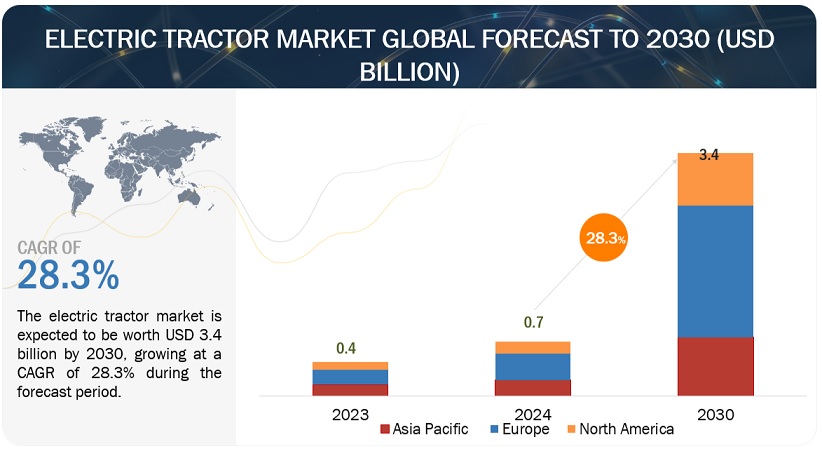
To know about the assumptions considered for the study, Request for Free Sample Report
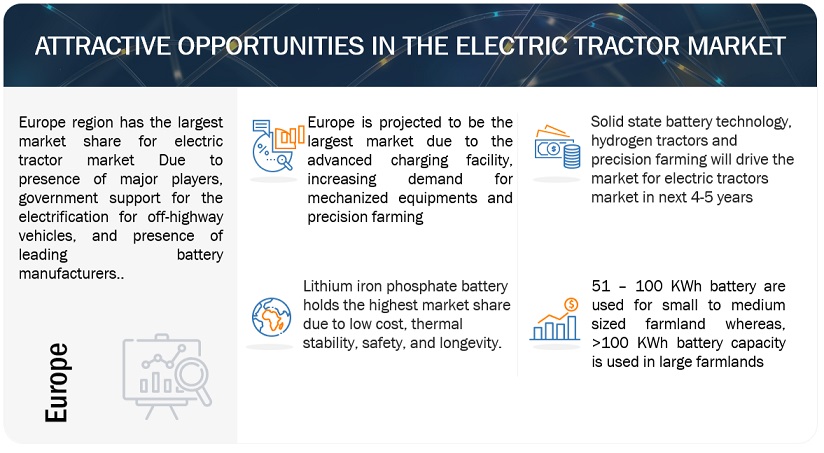
To know about the assumptions considered for the study, download the pdf brochure
Market Dynamics
DRIVER: Growing stringent emission regulations
The stringent emission norms and regulations have significantly increased the sales of electric tractors globally. Key countries like the US, Europe, Canada, India, China, and Japan have implemented emission regulations for tractors to address environmental concerns and reduce air pollution. Due to growing environmental concerns and excessive use of non-renewable resources, governing bodies globally have initiated many strict steps. For instance, critical countries like Europe have been following Stage V emission norms since January 2019, where the NOx limit is set to 2.0 g/kWh for engines > 56 kW and PM at 0.015 g/kWh. In comparison, the US follows EPA Tier 4 regulations in which the NOx limit is set to 2.4 g/kWh for engines > 80 kW and PM at 0.015 g/kWh. Hence, these strict emission norms have shifted the trend towards electric tractors and are slowly gaining momentum in sales globally.
These regulations impose far harsher limits on pollutants like NOx, PM, and HC than previous standards. For example, Stage 5 in the EU reduces NOx by 56% and PM by 47% compared to Stage IV. Meeting these limits with conventional diesel engines becomes increasingly expensive and technically challenging, pushing manufacturers towards exploring cleaner alternatives like electric tractors. Also, the stringent emission control technologies needed for diesel tractors under new regulations will increase production and maintenance costs. This price hike makes electric tractors, with potentially lower operating costs due to cheaper electricity, a more attractive alternative. This aided the development of hybrid and electric tractors and equipment that are emission-free, noise-free, and more efficient than their IC engine counterparts. Hence, considering all the factors, such as emission norms and price hikes, will lead to a substantial shift towards electric tractors. While affordability remains a consideration, the combined pressure of rising diesel costs, environmental concerns, government support, and technology advancements are making electric tractors a more attractive and viable option for the future of agriculture.
RESTRAINT: Thermal Management and operational challenges
Thermal management is a critical aspect of electric tractor design, encompassing various challenges such as leaks, corrosion, clogging, climate sensitivity, and battery aging. Leaks and corrosion can occur within the battery system due to thermal stresses, leading to electrolyte leakage and degradation of battery components over time. Additionally, clogging may occur in cooling channels or passages, hindering the effective heat dissipation from the battery. Climate conditions also play a significant role, as extreme temperatures can exacerbate thermal stresses and accelerate battery degradation. Moreover, as batteries age, their thermal performance may deteriorate, further complicating the management of heat generation and dissipation within the electric tractor's battery system.
In addition to thermal management concerns, the high prices are significant barriers to adopting electric tractors. Extended charging times can result in operational downtime, limiting the productivity and efficiency of farm electric tractors. Moreover, the high cost of electricity, especially during peak demand periods, can significantly increase the overall operating expenses associated with electric tractor usage. For instance, a farmer operating an electric tractor may find that the lengthy charging times required to replenish the battery limit the tractor's availability for essential farming tasks, leading to scheduling conflicts and reduced productivity.
Additionally, the high cost of electricity for charging the tractor's battery may outweigh the potential savings in fuel expenses, especially in regions with relatively high electricity prices. These factors collectively contribute to farmers' hesitation to invest in electric tractors despite their potential long-term benefits in terms of reduced emissions and operating costs. Addressing these challenges requires innovative solutions in battery technology, charging infrastructure, and policy support to make electric tractors more accessible and economically viable for farmers worldwide.
OPPORTUNITY: Emergence of Hydrogen-powered electric tractors
Determining the optimal type of tractor depends on several factors, including environmental impact, operational efficiency, and cost-effectiveness. Diesel tractors, while reliable and widely used, emit pollutants and greenhouse gases, contributing to air pollution and climate change. Electric tractors offer zero tailpipe emissions and lower operating costs than diesel but suffer from limited driving ranges per charge and higher upfront costs. However, advancements in battery technology and charging infrastructure are improving their viability. Hydrogen tractors, leveraging fuel cell technology, promise zero emissions and fast refueling times compared to diesel engines but are yet facing challenges such as limited hydrogen infrastructure and higher upfront costs.
Key players are investing heavily in R&D to develop alternating fuel technology for tractors. Several key players in the agricultural machinery industry have showcased their hydrogen tractors in exhibitions and trade shows. Indian tractor manufacturer TAFE showcased their first hydrogen-powered tractor at the Agritechnica trade fair held in Hannover, Germany. In June 2022, Kubota Corporation (Japan) announced the launch of its first hydrogen-powered fuel cell tractor in 2025. The commercialization timeline for H2ICE tractors will take over a decade. However, specific timelines for widespread commercialization may vary depending on factors such as hydrogen infrastructure's readiness, fuel cell technology advancements, and market acceptance.
These are some key developments for hydrogen manufacturing, which is considered to have a promising future. In the future, the momentum in tractor technology will shift towards electric and Hydrogen engine alternatives as concerns over emissions and sustainability drive agricultural innovation. Concurrently, H2ICE tractors offer the promise of zero emissions, longer driving ranges, and faster refueling times, contingent upon advancements in hydrogen infrastructure and production. Despite challenges, electric and H2ICE tractors will play a pivotal role in sustainable agriculture, reshaping the landscape of farming towards greener and more efficient practices.
CHALLENGE: High cost of electric tractors
The higher cost of electric tractors compared to their diesel counterparts can be attributed to several factors inherent in electric vehicle technology. Firstly, the cost of manufacturing lithium-ion batteries, which are crucial components of electric tractors, remains relatively high despite advancements in battery technology. Additionally, electric tractors require specialized electric drive systems, such as motors and inverters, which can be more expensive to produce and integrate than conventional mechanical drivetrains in diesel tractors. Ongoing research and development efforts to optimize electric tractor performance and reliability also increase upfront costs.
Considering the price comparison, electric tractors are 40 – 50% more expensive than diesel tractors. These are due to the battery pack, which is the most expensive component in an electric tractor. Advanced battery technologies like lithium-ion batteries, commonly used in electric vehicles, including tractors, can be costly to manufacture. Also, diesel tractors have been mass-produced for many years, leading to economies of scale that help drive down costs. In contrast, the Electric tractors, on the other hand, may not yet benefit from the same mass production level, leading to higher per-unit costs. Since electric tractors are still relatively new, manufacturers may price them higher initially due to factors such as perceived value, environmental benefits, and the willingness of early adopters to pay a premium.
Lastly, electric tractor models' limited availability restricts consumer choice, potentially hindering adoption. The lack of widespread charging infrastructure further complicates matters, particularly in rural areas where agricultural operations are prevalent. Moreover, electric tractors require specialized technical expertise for maintenance and aftersales support, posing concerns for farmers who may need more training. Overcoming these challenges will require concerted efforts to reduce upfront costs, expand model options, invest in charging infrastructure and technical training programs, and ensure compliance with safety standards. As technology evolves and market dynamics shift, these obstacles are expected to become more manageable, paving the way for broader acceptance and adoption of electric tractors in the agriculture industry.
Electric Tractor Market Ecosystem.
The major electric tractor market companies have the latest technologies, diversified portfolios, and global distribution networks. The major players in the electric tractor market include Kubota Corporation (Japan), Solectrac (US), AGCO Corporation (US), CNH Industries NV (Netherlands), and Escorts Kubota Limited (India).
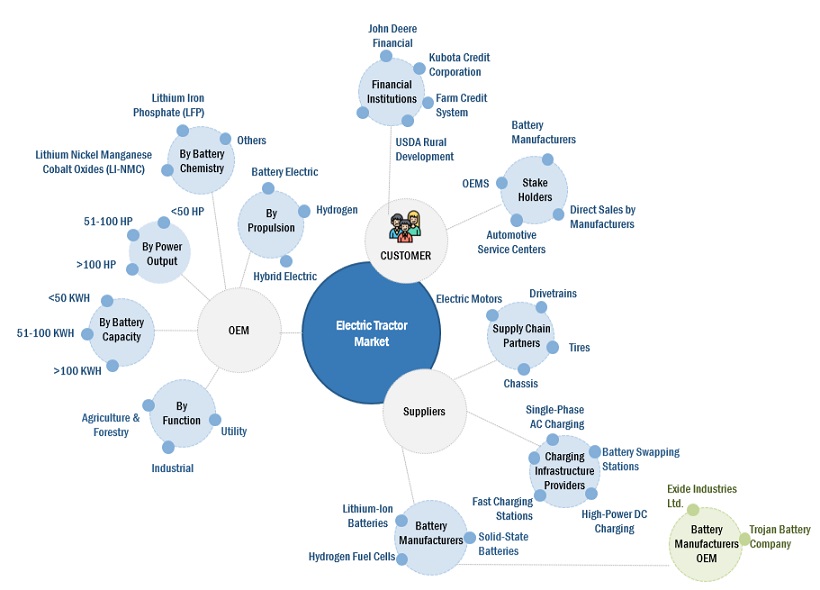
The battery electric segment is estimated to be the largest market during the forecasted period.
The agricultural landscape is shifting gears, and battery electric tractors (BETs) are leading the charge. A critical factor fueling battery electric tractors is the continuous decline in lithium-ion battery costs. According to industrial experts, the battery price may be reduced by 30-45% by 2026, making battery electric tractors even more cost-competitive than their diesel counterparts. Key players are investing in R&D to reduce the cost of batteries, technological advancements in battery chemistry and design, and exploration of alternative materials like sodium-ion, solid-state batteries, and lithium-iron-phosphate batteries, offering potentially even more affordable solutions.
The emission and noise control regulations for various vehicles and equipment have constantly been upgraded at regional levels. So, according to the EU emission regulations, on March 28, 2023, the European Union (EU) adopted an amendment to the CO2 standards for light-duty vehicles (LDV). The amendment includes the following targets: a 15% reduction by 2025, a 55% reduction by 2030, and a 100% reduction by 2035. Moreover, the Euro 7 regulations will be implemented from July 2025, which will have emission limits of 3mg/km for pure electric vehicles, 7mg/km for most internal combustion engine (ICE), hybrid electric and fuel cell vehicles, and 11mg/km for large ICE vans. China, Japan, South Korea, and India are also expected to follow the same norms in line with the EU and US standards. With the growing diesel prices, farmers in developing economies would eventually look up electric options for the same equipment for agricultural purposes. Hence, the demand for battery electric farm tractors will increase in the coming years.
States like California have an ambitious climate goal in America that has propelled the adoption of the battery electric tractor (BET). The California government has offered a scrappage policy for their old vehicles to which they are giving the Core Voucher to buy the electric tractors with the amount of USD 16,147 for e25G Gear, USD 13,753 for e25H Hydrostatic, and finally, USD 28,000 for buying eUT+ Narrow. In Europe, the "Farm to Fork" strategy champions sustainable agriculture, fueling the demand for electric solutions. Significant players like AGCO Corporation, Fendt, and New Holland actively respond with new BET models. Meanwhile, Asia Pacific markets like China and India are catching the wave, driven by rising fuel costs and air quality concerns. Local players like Mahindra & Mahindra, Cellestial Emobility Pvt Ltd, AutoNXT Automation Pvt Ltd, HAV, TAFE, VTL, Sonalika, and Montra Tractors are joining the race, eager to capitalize on this growing opportunity.
Additionally, government policies like stricter emission regulations and subsidies for battery electric tractors are further shaping regional trends. However, there is an increase in the adoption of battery electric tractors due to the easy availability and accessibility of charging infrastructure in developed countries. Additionally, farmers' education and awareness regarding the benefits of battery electric tractors are crucial for market expansion.
Europe has significantly invested in electric vehicle infrastructure, including charging stations and renewable energy sources. This infrastructure supports the adoption of battery electric tractors by providing the necessary charging infrastructure for electric vehicles. According to Markets and Market Analysis, the global EV charging station is valued at USD 11.9 billion in 2022 and is projected to grow around USD 76.9 billion in 2027. Furthermore, the European region has key players such as Fendt (Germany), Case IH (US), Antonio Carraro (Italy), Rigitrac (Switzerland), Sabi Agri (France), Tadus (Germany), ZY Elektric (Turkey) and Valtra (Finland).
Lithium Nickel Magnesium Cobalt Oxide is the fastest-growing battery chemistry segment for the electric tractor market.
There is an increase in the adoption of lithium nickel manganese cobalt oxide (Li-NMC) batteries in electric tractors. This reflects a broader global trend towards electrification in agriculture, driven by the need to reduce emissions and increase efficiency. The Li-NMC batteries rapidly transform the agricultural landscape, powering the electric tractor revolution. Their high energy density, fast charging capability, and long lifespans offer significant advantages over traditional lead-acid batteries, translating to longer ranges, shorter turnaround times, and lower operating costs for farmers.
The Li-NMC batteries are used in electric tractors due to their robust energy density and remarkable power output. These batteries enable extended operational periods for large field farms without frequent recharging. Their advantages lie in their ability to store ample energy within a compact structure and swiftly deliver substantial power, essential for operating high-power machinery like hydraulic pumps. Despite their remarkable performance, NMC batteries come with a few considerations. Their higher cost than alternative battery types, such as lead-acid batteries, remains a notable drawback. Safety concerns regarding thermal runaway, a potentially hazardous condition arising from overheating, underscore the need for careful assessment when deploying these batteries in construction equipment.
The global market presents a nuanced landscape in battery preferences. While Europe and North America lean towards NMC batteries for their higher energy density and anticipation of consumer acceptance regarding added costs, China opts for LFP batteries, emphasizing affordability amid rapid vehicle electrification. This divergence stems from supply chain preferences, with over 75% of European and North American offerings favoring NMC, especially in heavy-duty vehicles. At the same time, China leans towards LFP due to its cost-effectiveness amidst the electrification surge. The Escorts Kubota (India) FT25G, Solectrac (US) e25G Gear, and Solectrac e25H are offered with lithium-ion NMC battery packs. These batteries promise superior energy density, compact design, and heightened durability.
These batteries offer higher energy density than LFP, translating to a more extended range per charge. This is crucial for tractors operating on large farms with diverse needs. For instance, the Fendt (Germany) e100 Vario with Li-NMC batteries claims a range of up to 250 km (155 miles), while the New Holland (Italy) T6 Methane Power with LFP batteries offers a range of up to 130 km (81 miles). Adding further, the availability of battery pack suppliers such as Northvolt AB (Sweden), Forsee Power (France), and Volta Charging (US) has predominantly driven the adoption of NMC in electric tractors. More than 75% of offerings from European and North American pack manufacturers currently utilize NMC. Hence, as the Li-NMC battery technology matures and cost advantages become more evident, its market share is expected to grow.
51 – 100 KWh to hold the largest market share in the battery capacity segment for the electric tractor market
The 51 - 100 kWh battery capacity range has emerged as the most prevalent choice among farmers and manufacturers in the global electric tractor market. This preference stems from factors influencing performance, cost, and practicality across various regional landscapes. In the Americas, where agriculture often spans vast expanses of land, the need for tractors with sufficient range is paramount. The 51 - 100 kWh range strikes a balance, offering adequate power for extended operations without burdening farmers with excessive costs. In the Americas, where vast farmlands are commonplace, the success of models like the Case IH Magnum Electric showcases the practicality of the 51 - 100 kWh battery capacity range. With its ability to cover large areas on a single charge, this tractor has gained popularity among farmers looking to reduce operational costs and environmental impact.
Moreover, initiatives such as the United States Department of Agriculture's Rural Energy for America Program (REAP) provide financial assistance to farmers adopting electric tractors, further driving demand for models within this battery capacity range. Similarly, in Europe, where environmental concerns and regulatory incentives drive electric vehicle adoption, this battery capacity range aligns well with subsidy schemes and emission reduction goals. Europe is the fastest growing market for 51-100 kWh battery capacity in the electric tractor market. The European Green Deal in 2020 has also made an ambitious plan for achieving climate neutrality by 2050, due to which it has propelled the use of electric tractors in sustainable agriculture, creating a solid market for clean technologies like 50-100 kWh electric tractors, offering significant emissions reduction compared to traditional models. Also, Europe has more medium-sized farms than other regions like North America, making 50-100 kWh tractors ideal for their power requirements and farm size. In developed countries like France, their governing body launched a USD 117.3 million investment plan in October 2023 to support purchasing electric and hybrid agricultural equipment, including 50-100 kWh tractors.
Moving to the Asia-Pacific region, the diversity of agricultural practices necessitates a versatile solution. The 51 - 100 kWh range caters to small-scale farming and more extensive plantations, providing the necessary power without being overly bulky or expensive. Furthermore, this battery capacity range is an ideal entry point in emerging markets where electric tractor adoption is still nascent. Its combination of performance and affordability makes it an attractive option for farmers exploring sustainable alternatives to traditional diesel tractors.
The dominance of the 51 - 100 kWh battery capacity range can meet the needs of farmers while navigating regional nuances. It strikes a delicate balance between power, cost-effectiveness, and practicality, making it the preferred choice over smaller (<50 kWh) and larger (>100 kWh) battery capacities. While smaller capacities may need more range and power for demanding agricultural tasks, larger capacities may be prohibitively expensive or impractical in charging infrastructure. Thus, the 51 - 100 kWh range emerges as the optimal solution, capturing the highest market share worldwide in the electric tractor industry.
Europe holds the largest share of the electric tractor market.
Europe holds the highest market share for electric tractors due to regulatory incentives, environmental consciousness, and technological advancements. The European Union's stringent emissions regulations and ambitious sustainability goals have propelled the adoption of electric vehicles, including tractors. In particular, the Farm to Fork Strategy (2020) forms a key part of the European Green Deal and sets ambitious targets for the agricultural sector, aiming to reduce greenhouse gas emissions from agriculture by 50% by 2030 compared to 2019 levels and increase the area under organic farming to 25% of total agricultural land by 2030 compared to 8.1% in 2020 commitment to reducing greenhouse gas emissions under initiatives like the European Green Deal has incentivized farmers to transition towards electric alternatives. Also, the governing body took significant measures in France to mitigate its emissions. In 2017, the French government instituted mandatory clean air windscreen stickers, necessary for entry into specific cities, forming what is known as ZFE zones (Zone à Faibles Émissions), which regulate the access of vehicles lacking environmental badges. Hence, these regulations have steadily attracted the OEMs to manufacture electric tractors to reduce emissions. Moreover, European governments offer substantial subsidies and incentives to promote the adoption of electric tractors. Programs such as the Common Agricultural Policy (CAP) and the European Union's Horizon Europe framework provide funding and support for farmers investing in sustainable agricultural practices, including electrification.
Technological advancements in electric vehicle technology have also contributed to Europe's dominance in the electric tractor market. European manufacturers, such as Fendt's e100 Vario & e107 V Vario, Case IH's Farmall 75C, Antonio Carraro's TTR 7600 Infinity, Rigitrac's SKE 50 & Rigitrac SKE 40, Sabi Agri's ALPO Electric, Landini's REX4, Tadus's E-Traktor, ZY Elektric's King Size 320 HP, AUGA's M1, Keestrack's B1e, and Valta's E40 have been at the forefront of developing innovative electric tractor models with advanced features and capabilities. These models offer farmers efficient performance, lower operating costs, and reduced environmental impact compared to traditional diesel tractors.
Furthermore, the region's well-developed infrastructure, including a widespread network of charging stations and support services, facilitates the adoption and integration of electric tractors into agricultural operations. According to Statzon, in the second quarter of 2023, the European Union has about 550,000 public charging points for electric vehicles. This includes 11% DC chargers and 89% AC chargers. The Netherlands and Germany have almost 40% of all public chargers in the EU. This infrastructure investment, with favorable government policies and consumer preferences for environmentally friendly products, has created a conducive environment for the growth of the European electric tractor market.
Germany is transitioning from conventional tractors to electric tractors due to government initiatives to reduce greenhouse gas emissions. Adopting energy-efficient agricultural equipment is crucial for realizing Germany's broader goal of reducing total greenhouse gas (GHG) emissions by 40% by 2030 and achieving carbon neutrality by 2040. Also, there is a concentration of key players in Germany for electric tractors, such as Fendt, Aebi Schmidt, Tadus, etc. Moreover, Germany has a rising appetite for autonomous tractors within the country, which will drive the electric tractor market.
Europe's leadership in the electric tractor market can be attributed to its comprehensive regulatory framework, financial incentives, technological innovation, and supportive infrastructure. These factors have positioned the region as a global leader in the transition towards sustainable agriculture, driving the widespread adoption of electric tractors across European farming communities.
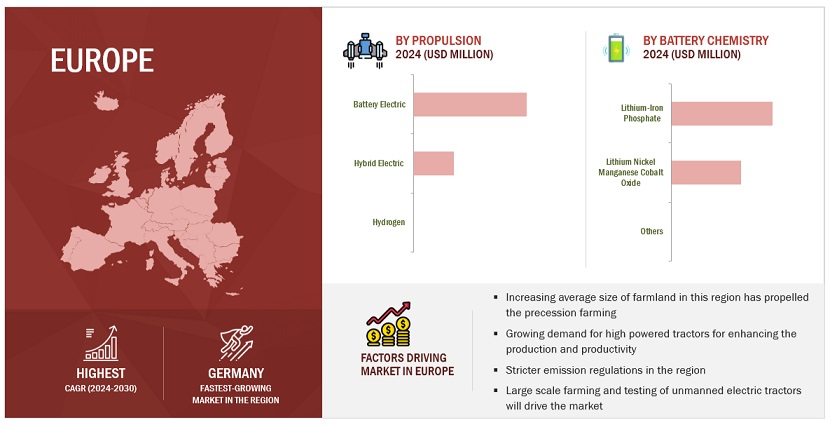
Key Market Players
Major manufacturers in the electric tractor market include Kubota Corporation (Japan), Solectrac (US), AGCO Corporation (US), CNH Industrial N.V. (Netherlands), Escorts Kubota Limited (India), Monarch Tractor (US), Deere & Company (US), Yanmar Holdings Co., Ltd. (Japan), Cellestial Emobility Pvt Ltd (India), International Tractors Limited (India), Proxecto (India), AutoNXT Automation Pvt. Ltd. (India), Rigitrac Traktorenbau AG (Switzerland), Sabi Agri (France), Agro Tractors S.p.A. (Italy), Foton Lovol (China), Tractors And Farm Equipment Limited (India), VST Tractors (India), Motivo Engineering (US), Tadus GMbH (Germany), ZY Elektrikli Traktör (Turkey), AUGA (Lithuania), ZTractors (US), and Amos Power (US).
Get online access to the report on the World's First Market Intelligence Cloud
- Easy to Download Historical Data & Forecast Numbers
- Company Analysis Dashboard for high growth potential opportunities
- Research Analyst Access for customization & queries
- Competitor Analysis with Interactive dashboard
- Latest News, Updates & Trend analysis
Request Sample Scope of the Report
Get online access to the report on the World's First Market Intelligence Cloud
- Easy to Download Historical Data & Forecast Numbers
- Company Analysis Dashboard for high growth potential opportunities
- Research Analyst Access for customization & queries
- Competitor Analysis with Interactive dashboard
- Latest News, Updates & Trend analysis
|
Report Attribute |
Details |
|
Market size available for years |
2021–2030 |
|
Base year considered |
2023 |
|
Market Growth forecast |
USD 3.43 Billion by 2030 from USD 0.77 Billion in 2024 at 28.3% CAGR |
|
Forecast period |
2024–2030 |
|
Forecast units |
Value (USD Million/Billion) |
|
Segments Covered |
Propulsion, Battery Chemistry, Function, Hybrid Electric Tractor Market, by Power Output, and Battery Capacity |
|
Geographies covered |
Asia Pacific, Americas, and Europe |
|
Top Players |
Kubota Corporation (Japan), Solectrac (US), AGCO Corporation (US), CNH Industries NV (Netherlands), and Escorts Kubota Limited (India). |
With the given market data, MarketsandMarkets offers customizations per the company’s specific needs.
The study segments the Electric Tractor Market:
Electric Tractor Market, By Propulsion
- Battery Electric
- Hybrid Electric
- Hydrogen
Electric Tractor Market, By Battery Chemistry
- Lithium-Iron Phosphate (LFP)
- Lithium Nickel Magnesium Cobalt Oxide (Li-NMC)
- Others
Hybrid Electric Tractor Market, By Power Output
- <50 HP
- 51 – 100 HP
- >100 HP
Electric Tractor Market, By Battery Capacity
- <50 KWh
- 51 – 100 KWh
- >100 KWh)
Electric Tractor Market, By Function
- Agriculture & Forestry
- Utility
- Industrial
Electric Tractor Market By Region
- Americas
- Europe
- Asia Pacific
Recent Developments
- In November 2023, The Fendt launched the e107 V Vario electric tractor, a fully battery-electric, narrow-track tractor designed for specialized applications in orchards, vineyards, greenhouses, and municipalities. The e107 V Vario has a maximum power output of 68 horsepower (50 kW) and a battery capacity of 100 kWh, which provides an estimated range of 4 to 7 hours for partial load applications such as cutting, mowing, or road maintenance.
- In September 2023, Kubota Corporation launched the "Future Cube" webpage, which showcases a fully autonomous electric tractor prototype, highlighting Kubota's research and development in advanced agricultural technologies. Unveiled at CES March 2023, this exhibition highlighted Kubota's vision for the future of farming, where sustainability, automation, and data-driven insights come together to revolutionize agricultural practices.
- In August 2023, Solectac launched the eUT+ Narrow electric tractor, a zero-emission electric tractor. This vehicle is designed to be comparable to diesel tractors, with a hitch that can lift 5,500 pounds. The eUT+ Narrow has 60 kWh / 560 amps at 106 volts, Lithium Iron phosphate (LFP), and a 70HP. This tractor is offered at USD 7499 for a 12-inch bucket attachment with a 19kW motor capacity.
- In August 2023, Solectrac launched the e25H model, a compact and accessible electric tractor ideal for smaller farms, vineyards, and landscaping endeavors. It comes with 25HP power to tackle lighter tasks like mowing, tilling, and hauling with its electric motor's instant torque. This eco-friendly machine boasts a 5-hour range on a single charge, catering to most workday needs. Maneuvering tight spaces is a breeze thanks to its compact size and foldable ROPS, while features like LED headlights and a PTO enhance its versatility. The company also offers a 19kW motor with Li NMC battery with this tractor.
- In September 2022, The Kubota launched LXe-261, a 26-horsepower, four-wheel drive electric tractor currently available for lease in Europe (France, Germany, United Kingdom, Spain, etc.). It is the first electric tractor launched by Kubota. The LXe-261 has a lithium-ion battery that provides up to three to four hours of operating time on a single charge. The battery can be fast charged in one hour.
Frequently Asked Questions (FAQ):
What is the current market size of the electric tractor market?
The electric tractor market is estimated to be USD 0.7 billion in 2024 and is projected to reach USD 3.4 billion by 2030 at a CAGR of 28.3%.
What are the driving factors of the electric tractor market?
Stringent government emission norms and regulations, incentives on EV tractors, and finance credits drive the electric tractor market.
Who are the top key players in the electric tractor market?
Major manufacturers in the electric tractor market include Kubota Corporation (Japan), Solectrac (US), AGCO Corporation (US), CNH Industries NV (Netherlands), and Escorts Kubota Limited (India). These companies focus on developing new products and partnerships, undertake collaborations, and mergers & acquisitions to gain traction in these growing electric tractors.
What are the market trends in the electric tractor market?
The hydrogen tractors, solid-state batteries, and increased charging infrastructure are expected to see growth opportunities in the electric tractor market ecosystem.
What are the challenges faced by electric tractor manufacturers globally?
The high cost of electric tractors is the biggest challenge for them. .
To speak to our analyst for a discussion on the above findings, click Speak to Analyst
Various secondary sources, directories, and databases have been used to identify and collect information for an extensive electric tractor market study. The study involved four main activities in estimating the current size of the electric tractor market: secondary research, validation through primary research, assumptions, and market analysis. Exhaustive secondary research was carried out to collect information on the market, such as different propulsion types and the upcoming technologies and trends. The next step was to validate these findings, assumptions, and market analysis with industry experts across the value chain through primary research. The top-down approach was employed to estimate the complete market size for different segments considered in this study.
Secondary Research
In the secondary research process, various secondary sources have been used to identify and collect information useful for an extensive commercial study of the electric tractor market. Secondary sources include company annual reports/presentations, press releases, industry association publications [such as publications on Committee for European Electric Off-highway Vehicle (CECE), Environmental Protection Agency (EPA), Agriculture Equipment Manufacturers Union (AXEMA), Association of Equipment Manufacturers (AEM), Italian Agricultural Machinery Manufacturers Federation (FEDERUNACOMA), Japan Agricultural Machinery Manufacturers Association (JAMMA), China Agricultural Machinery Distribution Association (CAMDA), VDMA (Verband Deutscher Maschinen- und Anlagenbau), Russian Association of Specialized Machinery and Equipment Manufacturers (ROSSPETSMASH), Brazilian Association of Industrial Machinery and Equipment (ABIMAQ), Agricultural Engineers Association (AEA). The electric tractor-related magazine articles, directories, technical handbooks, World Economic Outlook, trade websites, and technical articles. Additionally, secondary research has been carried out to understand the average cost of electric tractors, which come with different battery capacities, and the historical sales of vehicles.
Primary Research
In the primary research process, various primary sources from both the supply and demand sides were interviewed to obtain qualitative and quantitative information on the market. The primary sources from the supply side included industry experts such as CXOs, vice presidents, directors from business development, marketing, product development/innovation teams, and related key executives from various key companies. Various system integrators, industry associations, independent consultants/industry veterans, and key opinion leaders were also interviewed.
In the primary research process, various sources from both the supply and demand sides have been interviewed to obtain qualitative and quantitative information for this report. The primary sources from the supply side include industry experts such as research and development experts, CEOs, CTOs, COOS, vice presidents, marketing directors, technology and innovation directors, and related key executives from different key companies operating in the electric tractor market.
After the complete market engineering, which includes calculations for market statistics, market breakdown, market size estimations, market forecasting, and data triangulation, extensive primary research has been conducted to gather information and verify and validate the critical numbers arrived at. Primary research has also been undertaken to identify and validate the segmentation, industry trends, key players, competitive landscape, and market dynamics, such as drivers, restraints, opportunities, challenges, industry trends, and key strategies. Extensive qualitative and quantitative analysis has been performed on the complete market engineering process to list key information/insights throughout the report.
After interacting with industry experts, we have also conducted brief sessions with highly experienced independent consultants to reinforce the findings from our primaries. This and the in-house subject matter expert’s opinions have led us to the conclusions described in this report's remainder.
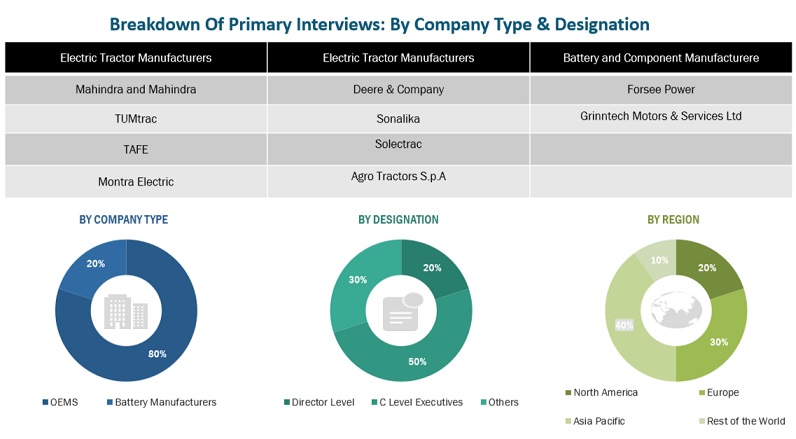
To know about the assumptions considered for the study, download the pdf brochure
Market Size Estimation
A detailed market estimation approach was followed to estimate and validate the value of the electric tractor market and other dependent submarkets, as mentioned below:
- Key players in the electric tractor market were identified through secondary research, and their global market shares were determined through primary and secondary research.
- The research methodology included studying annual and quarterly financial reports, regulatory filings of major market players (public), and interviews with industry experts for detailed market insights.
- All industry-level penetration rates, percentage shares, splits, and breakdowns for the electric tractor market were determined using secondary sources and verified through primary sources.
- All key macro indicators affecting the revenue growth of the market segments and sub-segments have been accounted for, viewed in extensive detail, verified through primary research, and analyzed to get the validated and verified quantitative and qualitative data.
- The gathered market data was consolidated and added with detailed inputs, analyzed, and presented in this report.
Electric Tractor Market: Bottom-Up Approach
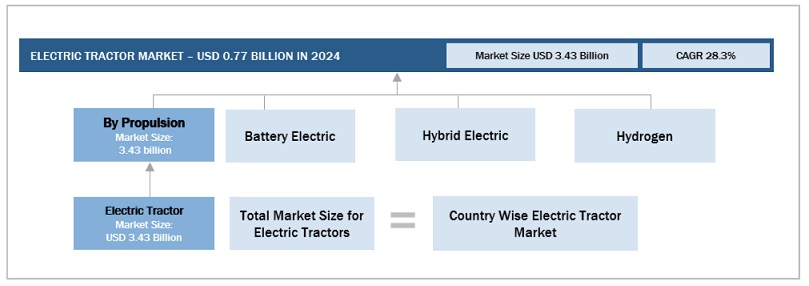
To know about the assumptions considered for the study, Request for Free Sample Report
Electric Tractor Market: Top-Down Approach
Extensive secondary and primary research was conducted to understand the global market scenario and penetration for hybrid tractors per region. While estimating the regional market for hybrid electric tractors by power output, the regional shares of <50HP, 51 – 100HP, and >100HP power output were identified and multiplied by the regional market size in terms of the volume, of hybrid electric tractors. In terms of volume, the regional-level market size was then multiplied by the regional-level average selling price of the hybrid electric tractor mentioned above and the power output of the tractor. This resulted in regional-level market size, by powerout put, in terms of value. This information was validated through primary interviews with OEMs and Tier I suppliers.


Data Triangulation
After arriving at the overall market size, the market was split into several segments and sub-segments—using the market size estimation processes as explained above. Where applicable, data triangulation and market breakdown procedures were employed to complete the overall market engineering process and determine each market segment's and sub-segments exact statistics. The data was triangulated by studying various factors and trends.
Market Definition
Electric tractors include both battery-electric and hybrid-electric tractors. The hybrid electric tractor is powered by an internal combustion engine (ICE) combined with one or more electric motors that use energy stored in batteries to meet the additional auxiliary power needs of the equipment, electronic devices, and power tools. The battery-electric tractor is fully electric, and the combustion engine is replaced with batteries and an electric motor that powers the movement of the machine and its attachments.
These tractors provide zero emissions, reduce carbon footprint, and contribute to sustainability goals. They also operate silently, improving the work environment and potentially complying with noise regulations. Functionally, electric tractors perform the same tasks as their diesel counterparts, including soil preparation, seeding, harvesting, and transporting materials. However, they come with distinct features such as regenerative braking that feeds energy back to the battery, multiple power levels catering to various needs, and connected data monitoring and optimization technologies.
Stakeholders
- Electric Tractor Component Manufacturing Associations
- Electric tractor Component Suppliers
- Farm Tractor Dealers and Distributors
- Government and Regulatory Authorities
- Research Professionals
- Farm Tractor Importers, Retailers, and Dealers
- Tier 1 System Suppliers
- Raw Material Suppliers for Electric Farm Tractor
- Battery and Drivetrain Suppliers
- Electric Tractor Manufacturers
- Electric tractor Manufacturers
- Traders, Distributors, and Suppliers of Electric tractor Systems/Components
- Automotive Industry Associations, Government Authorities, and Research Organizations
Report Objectives
-
To define, describe, and forecast the electric tractor market in terms of value
(USD million), based on the following segments: - Propulsion (Battery Electric, Hybrid Electric, and Hydrogen)
- Battery Chemistry (Lithium Iron Phosphate (LFP), Lithium nickel manganese cobalt oxides (LI-NMC), and Others)
- Hybrid Electric Tractor Market, by Power Output (<50 HP, 51-100 HP, and >100 HP)
- Battery capacity (<50 KWH, 51-100 KWH, and >100 KWH)
- Function (Agriculture & Forestry, Utility, and Industrial)
- Region (Asia Pacific, Europe, and Americas)
- To understand the market dynamics (Drivers, Restraints, Opportunities, and Challenges) and conduct Patent Analysis, Pricing Analysis, Recession Impact, Key Buying Criteria, Trade Analysis, Technology Analysis, ASP Analysis, Trades and Conferences, Case Study Analysis, Supply Chain Analysis, Regulatory Analysis, Key Conference and Events, Bill of Material, Total Cost of Ownership, Investment & Funding Scenario, Funding by Use Case Scenario, Battery Technology, and Ecosystem Mapping
- To understand the dynamics of the market players and distinguish them into stars, emerging leaders, pervasive players, and participants according to their product portfolio strength and business strategies.
- To strategically analyze markets concerning individual growth trends, prospects, and contributions to the total market
- To analyze recent developments, such as partnerships, supply agreements, joint ventures/mergers and acquisitions, geographic expansions, and product developments of key players in the market
Available Customizations
Along with the market data, MarketsandMarkets offers customizations based on company-specific needs.
The following customization options are available for the report:
Electric Tractor Market By Region
- UAE
- Saudi Arabia
- Egypt
Electric Tractor Market, By Battery Capacity
- Asia Pacific (China, India, Japan, South Korea, Rest of Asia Pacific)
- Europe (Germany, France, UK, Spain, Russia, Italy, Turkey, and Rest of Europe)
- Americas (US, Canada, Mexico, Brazil, and Argentina)
- Detailed Analysis And Profiling Of Additional Market Players (Up To 3)












Growth opportunities and latent adjacency in Electric Tractor Market